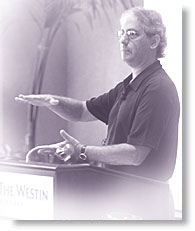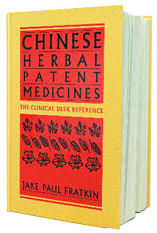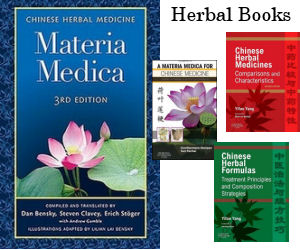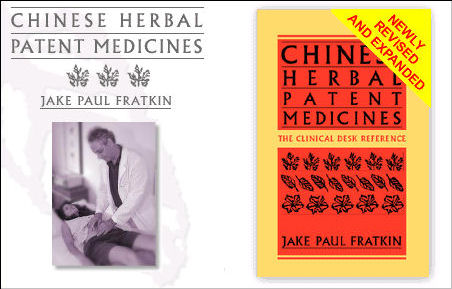Acupuncture & TCM Articles

Articles by Jake Paul Fratkin, OMD, LAc
Jake Fratkin, OMD, LAc, has been in the practice of Oriental medicine since 1978. Following undergraduate and graduate training at the University of Wisconsin in Chinese language and philosophy and pre-medicine, he pursued a seven-year apprenticeship in Japanese and Korean style acupuncture with Dr. Ineon Moon and a two-year apprenticeship in Chinese herbal medicine with Drs. Zhengan Guo and Pak-Leung Lau in Chicago. He also spent a year in Beijing hospitals interning in advanced herbal medicine, specializing in gastrointestinal and respiratory disorders, and pediatrics.  Dr. Fratkin is the author of several books, including Chinese Herbal Patent Medicines: The Clinical Desk Reference, and is the editor-organizer of Wu and Fischer's Practical Therapeutics of Traditional Chinese Medicine. In 1999, he was named the "Acupuncturist of the Year" by the American Association of Oriental Medicine.
Dr. Fratkin is the author of several books, including Chinese Herbal Patent Medicines: The Clinical Desk Reference, and is the editor-organizer of Wu and Fischer's Practical Therapeutics of Traditional Chinese Medicine. In 1999, he was named the "Acupuncturist of the Year" by the American Association of Oriental Medicine.
Chinese Herbal Patent Medicines: The Clinical Desk Reference
Hardback book, 1198 pages. This volume covers 1360 products, including 550 GMP level products and all of California FDB analysis on 505 products. Includes information on endagered animals, heavy metals, and pharmaceuticals. The text is organized into 12 groups, with a total of 109 chapters and includes material by Andrew Ellis, Subhuti Dharmananda, and Richard Ko. Over 80 pages of full-color photos (with English and Chinese cross-reference). Fully indexed.
The Treatment of Pertussis (Whooping Cough) With Chinese Herbal Medicine
Pertussis (whooping cough) is aptly called "the 100-day cough" (bai re ke) in Chinese medicine. Vaccinations against pertussis contained in the DPT (diphtheria-pertussis-tetanus) shot have reduced incidence in the United States significantly, but parental rejection of the vaccination has resulted in a re-emergence of the illness throughout the country. Both my city (Boulder) and state, (Colorado) hold the distinction of having the highest reported pertussis rates in the country. ("Colorado children are almost three times as likely to get whooping cough as children nationwide.")1 Subsequently, every winter I treat a handful of pertussis cases. The purpose of this paper is not only to talk about whooping cough and how to treat it, but also to discuss the treatment of cough in general. My opinion is that practitioners, in treating the various stages of cough, minimize the importance of addressing causative microbial agents, concentrating classically on the treatment of heat, dryness and phlegm. My approach recommends including Chinese herbs with strong antiviral or antibacterial effects.

In clinical practice, especially during the winter, many cases of cough come into the clinic. One should think about the possibility of pertussis in the following circumstances. The first consideration is whether there are reported outbreaks of pertussis in your community. The second consideration is whether the patient has had the cough for longer than two or three weeks. Third is whether the patient has "cough attacks" of repeated coughing, ending in the inability to catch one's breath, with a long inspiration followed again by coughing. The cough tends to be a sharp bark, similar to that observed in croup, and is more pronounced at nighttime.
In my practice, pertussis crosses all age lines and has been confirmed in infants, children, teens and adults. When suspected in the early stages, a diagnostic nasopharyngeal swab culture can be performed. A qualified technician can do the swab, and many (but not all) labs will offer it. This test is only positive in the early stages of the illness, and may be normal at the end of stage two. It is impossible to confirm by swab in stage three, although blood antibodies to the bacteria may be observed.
The Clinical Picture of Pertussis
Pertussis is a highly communicable disease caused by the bacteria Bordetella pertussis, a gram-negative coccobacillus. It is most common in school-aged children (elementary to high school). Pertussis is dangerous for infants, especially newborns, who often need to be hospitalized to facilitate breathing and to avoid choking to death; and in the elderly, who account for most of the deaths. The death rate outside of infants and elderly is very low, but the cough can be persistent for up to three months. Frequent nighttime coughing not only stresses the patient, but also the patient's family.
There is usually a 10- to 14-day incubation period after exposure to an infected person. The actual range is from seven days to 21 days until symptoms appear. Infections happen by aspiration, inhaling bacteria from someone's cough, sneeze or nasal discharge. The patient is most contagious for the first three weeks following their earliest symptom. The total illness, if uncomplicated, lasts from six to 12 weeks. There are three stages of the disease recognized in the medical literature; modern Chinese literature also uses these stages when treating with Chinese herbal medicine.
Stage one is the catarrhal phase. This lasts one to two weeks and starts like a common cold, with sneezing, lacrimation, listlessness and a runny nose of watery consistency. Fever is either absent or low-grade (less than 100.4º F). A dry hacking cough begins to develop, which gradually takes place more frequently at nighttime. At this stage, the patient is very contagious. In Chinese medicine, stage one is due to invasion of the lung and wei by a seasonal pestilential factor. This disrupts the descent of lung qi, causing cough. The treatment priority is to dispel pathogenic qi.
Stage two is called the paroxysmal phase. It lasts one to four weeks and consists of frequent, repetitive coughing fits, with five to 15 repetitive coughs. This may take place up to 50 times in a day. There may be the whooping sound in between coughs, due to a deep inspiration for air. The coughs are intense and sudden (paroxysms), with bulging and tearing eyes and a bluish discoloration to the face. Occasionally, vomiting of mucus may accompany the paroxysm. There is copious production of phlegm, which usually is swallowed by infants and children. The mucus will be obvious on the nares of children. This stage is also contagious, but less so than stage one. In Chinese medicine, the invading pestilential factor condenses fluid and turns to phlegm-fire. The severe gasping and coughing are the result of to an inability to expectorate sputum.
Stage three, called the recovery phase, starts around week four and lasts approximately seven weeks. During this stage, one has a chronic, less severe cough that gradually goes away. It is not a contagious stage. In Chinese medicine, this stage represents the damage of lung and spleen by long-term coughing, causing deficiency of qi and yin. In deficiency cases, residual coughing may remain for months.
In Western medicine, patients are treated with antibiotics, usually erythromycin, although this treatment provides no relief or help for the patient. It reduces contagion from cough or nasal discharge and is routinely given. An albuterol inhaler may be given to facilitate breathing. In infants and severely sick adults, a corticosteroid, usually betamethasone, is given. Patients need to be quarantined, especially from infants and elderly, for the first four weeks following the presentation of their earliest symptom.
Treatment With Chinese Herbal Medicine
Chinese herbal medicine offers significant help in the treatment and course of illness in pertussis, especially when one realizes that Western medicine offers only slight symptom control. I have treated all three stages successfully with the Chinese approach. In terms of research, I have found several references to successful inhibition of the Bordetella pertussis bacteria by Chinese herbs. Dr. Qing Zai Zhang cites Chinese studies showing the effectiveness of huang lian (rhizoma coptis) for the treatment of Bordetella pertussis.2 Dr. John Chen and Tina Chen report studies on the clinical application of bai ji (rhizoma bletillae) and bai bu (radix stemonae) on infant and pediatric pertussis,3, 4 as well as studies on other herbs.5
Treatment of whooping cough in mainland China takes the form of a decoction. Three authoritative textbooks, in English but from China, are essentially in agreement about the recommended formulas for the three stages.6
1. Catarrhal Stage (Invasion of Pathogenic Wind)
Signs and symptoms (SS): Similar to common cold: cough with clear dilute nasal discharge, sneezing, aversion to cold, thin white tongue coating and a floating tense pulse. Eventually wind-cold turns to heat, with increasingly heavy voice, a cough worse at night and worsening daily, inflamed throat, thicker phlegm discharge, red tongue and floating rapid pulse.
Treatment principle (TP): Stop the cough by relieving exterior syndrome and opening lung.
The literature offers two recommended formulas from which the practitioner may choose.
Formula One7 (for runny-nose stage)
Px: Jin Fo Cao San8
xuan fu hua (flos inulae), 9 gm
qian hu (radix peucedani), 6 gm
bai jie zi (semen sinapsis albae), 6 gm
xi xin (herba asari), 3 gm
bai bu (radix stemonae), 9 gm
chuan bei mu (bulbus fritillariae cirrhosae), 3 gm
zhi ban xia (rhizoma pinellia), 6 gm
ma huang (herba ephedrae), 3 gm
xing ren (semen armeniacae), 3 gm
sang ye (folium mori), 9 gm
ju hua (flos chrysanthemi), 9 gm
lian qiao (fructus forsythiae), 9 gm
For this stage, which resembles a common cold, we resolve exterior wind-heat, descend lung qi and clear watery phlegm-heat. In this formula, we find herbs that dispel wind (xi xin, ma huang, sang ye and ju hua), transform phlegm (xuan fu hua, qian hu, chuan bei mu and ban xia) and stop cough (bai bu, xing ren). In addition, lian qiao, an antiviral herb, clears heat and resolves toxin. Of particular use is bai bu for that sharp, barking cough peculiar to pertussis. The combination of xuan fu hua and bai jie zi addresses watery nasal discharge.
Formula Two9 (for beginning cough stage)
Px: Combine San Ao Tang, Sang Ju Yin and Dai Ge San
ma huang (herba ephedrae), 5 gm
xing ren (semen armeniacae), 10 gm
gan cao (radix glycyrrhizae), 5 gm
bai bu (radix stemonae), 10 gm
bai qian (rhizoma cynanchii stauntoni), 10 gm
sang ye (folium mori), 10 gm
ju hua (flos chrysanthemi), 10 gm
niu bang zi (fructus arctii), 10 gm
jie geng (radix platycodi), 5 gm
qing dai (indigo naturalis*), 6 gm
hai ge ke (concha cyclinae), 6 gm
*Substitute ban lan gen or da qing ye.
This approach is similar to that of formula one...with some significant adjustments. Niu bang zi addresses sore throat, while the last three herbs work together to break up thick sputum due to phlegm-fire. I would recommend formula one for the earlier presentation of watery nasal discharge, and formula two for more pronounced coughing and phlegm production. Experienced herbalists can modify these formulas as they wish.
Treatment with Chinese herbal products. For practitioners without access to custom formulas, I recommend combining several prepared products to achieve the effect of the recommended formulas. In this first stage, we need a formula that resolves exterior wind-heat and another formula to clear phlegm-heat. In addition, I strongly suggest adding an herbal product that has strong antiviral and antibacterial effects.
To resolve exterior wind-heat, choose from sang ju yin, yin qiao san or chai ge jie ji wan. To clear phlegm-heat, choose from qing qi hua tan wan, ning sou wan or similar products from American manufacturers. For reinforcing the antiviral effect with herbs that clear heat and resolve toxin, choose from huang lian jie du wan, gan mao ling, zhong gan ling, chuan xin lian, etc.
2. Paroxysmal Stage (Retention of Phlegm-Fire)
SS: Paroxysmal gasping coughs with a strong barking sound, thick sputum that is difficult to expectorate, noisy inhaling of breath, vomiting of mucus, red eye, occasional blood in sputum. The tongue is red with a yellow greasy or sticky coat, and the pulse is rapid, slippery and forceful.
TP: Clear heat, resolve toxins, transform phlegm, stop cough.
Two formulas are recommended for the practitioner to choose from.
Formula One10
su zi (fructus perillae), 9 gm.
ting li zi (semen lepidii seu descurainiae), 9 gm
wu wei zi (fructus schisandrae), 6 gm
meng shi (lapis chloriti), 6 gm
jie geng (radix platycodi), 9 gm
zhi shi (fructus aurantii immaturus), 6 gm
gua lou (fructus trichosanthis), 12 gm
da zao (fructus zizyphi jujubae), 5 pc
Modifications
With frequent, spasmodic and violent cough, add the following:
jiang can (bombyx batryticatus), 6 gm
di long (lumbricus), 6 gm
With dry cough with little sputum, add the following:
nan sha shen (radix adenophorae), 12 gm
tian men dong (radix asparagi), 12 gm
mai men dong (radix ophiopogonis), 12 gm
Formula Two11
Px: Sang Bai Pi Tang
sang bai pi (cortex mori albae radicis), 10 gm
huang qin (radix scutellariae baicalensis), 10 gm
huang lian (rhizoma coptidis), 2 gm
chao zhi zi (fructus gardeniae, fried), 10 gm
su zi (fructus perillae), 10 gm
xing ren (semen armeniacae), 10 gm
chuan bei mu (bulbus fritillariae cirrhosae), 5 gm
ting li zi (semen lepidii seu descurainiae), 10 gm
bai bu (radix stemonae), 10 gm
Formula two has stronger heat-clearing and antibacterial effects, combining huang qin, huang lian and zhi zi. These can be added to formula one. Similarly, the modifications of formula one can be applied to formula two.
Treatment with Chinese herbal products. This stage is the most serious in terms of repetitive cough, especially during nighttime. It represents a combined presentation of lung fire, deficiency of lung yin and a stage I call sticky phlegm-heat. Products for each group needed to be combined, with additional herbs to clear toxic heat (antiviral) or dispel damp heat (antibacterial).
For lung fire, choose from huang lian shang qing pian, qing fei yi huo pian, etc. For deficiency of lung yin, choose from bai he gu jin wan, sha shen mai men dong wan, etc. For accumulation of toxic heat or damp-heat, choose from huang lian jie du wan, gan mao ling, zhong gan ling, etc., or any product using significant amounts of ban lan gen and/or da qing ye. Also consider syrups or capsules containing man shan hong (radix rhododendri daurici) or zi hua du juan (radix rhododendri mariae), such as hsiao keh chuan.
3. Recovery Stage (Deficiency of Lung and Spleen)
This stage continues for two to three weeks, but may last several months. The severity of the paroxysmal cough and noisy inhalation gradually decreases.
A. Deficiency of Qi
SS: Weak cough, feeble low voice. Tongue may be pale and the pulse is weak.
TP: Tonify lung and spleen qi.
Px: Ren Shen Wu Wei Zi Tang
dang shen (radix codonopsis pilosulae), 9 gm
fu ling (poria), 9 gm
bai zhu (rhizoma atractylodis macrocephalae), 9 gm
mai men dong (radix ophiopogonis), 12 gm
wu wei zi (fructus schisandrae), 6 gm
gan cao (radix glycyrrhizae), 3 gm
sheng jiang (rhizoma zingiberis officinalis), 3 pc
da zao (fructus zizyphi jujubae), 5 pc
Treatment with Chinese herbal products. Choose from the following: cordyceps capsules (dong chong xia cao; pulvis cordyceps sinensis), American ginseng capsules (xi yang shen; radix panacis quinquefolii), qing zao jiu fei wan, sheng mai yin, liu jun zi wan, etc. Dong chong xia cao and xi yang shen are particularly helpful and should be used in most of these cases.
B. Deficiency of Yin
SS: Hoarse voice, dry cough, dry throat, red tongue, weak rapid pulse.
TP: Moisten lung yin
Px: Qing Zao Jiu Fei Tang, modified
nan sha shen (radix adenophorae), 9 gm
sang ye (folium mori), 9 gm
xing ren (semen armeniacae), 9 gm
mai men dong (radix ophiopogonis), 9 gm
tian men dong (radix asparagi), 9 gm
jie geng (radix platycodi), 9 gm
hei zhi ma (semen sesami indici), 12 gm
e jiao (gelatinum corii asini), 9 gm
da zao (fructus zizyphi jujubae), 5 pc
Treatment with Chinese herbal products. Choose from the following: cordyceps capsules (dong chong xia cao, pulvis cordyceps sinensis), American ginseng capsules (xi yang shen; radix panacis quinquefolii), qing zao jiu fei wan, sheng mai yin, bai he gu jin wan, sha shen mai men dong wan, etc. Again, the use of dong chong xia cao and xi yang shen is very helpful.
--------------------------------------------------------------------------------
References (for part one)
1 -Associated Press, Jan. 21, 2004.
2 -www.dr-zhang.com/LD/formulas/Coptin.htm.
3 -Chinese Medical Herbology and Pharmacology, p. 582.
4 -Ibid, p. 727.
5 -Ibid, p. 1106.
6 -Higher Education Press, Foreign Language Press and Academy Press. See Bibliography and Recommended Reading section below.
7 -This formula can be found both in Paediatrics; Volume 13 of The English-Chinese Encyclopedia of Traditional Chinese Medicine, p. 200, and in Treatment of Paediatric Diseases in Traditional Chinese Medicine, p. 246.
8 -Jin fo cao is another name for xuan fu hua (flos inulae).
9 -Essentials of Traditional Chinese Pediatrics, pp. 171-172.
10 -Paediatrics; Volume 13 of The English-Chinese Encyclopedia of Traditional Chinese Medicine, p. 201.
11 -Essentials of Traditional Chinese Pediatrics, pp. 172-173.
Bibliography and Recommended Reading
Chinese Herbal Medicine Materia Medica , 3rd ed. Dan Bensky, Steven Clavey and Erich Stöger, Eastland Press, Seattle, 2004. , 3rd ed. Dan Bensky, Steven Clavey and Erich Stöger, Eastland Press, Seattle, 2004.
Chinese Medical Herbology and Pharmacology . John K. Chen and Tina T. Chen, Art of Medicine Press, City of Industry, 2003. . John K. Chen and Tina T. Chen, Art of Medicine Press, City of Industry, 2003.
Essentials of Traditional Chinese Pediatrics . Foreign Language Press, Beijing, 1990. . Foreign Language Press, Beijing, 1990.
The Merck Manual . Mark H. Beer, MD, and Robert Berkow, MD, eds. Merck Research Laboratories, Whitehouse Station, NJ. Published yearly. . Mark H. Beer, MD, and Robert Berkow, MD, eds. Merck Research Laboratories, Whitehouse Station, NJ. Published yearly.
Notes From South Mountain. Andrew Ellis, The Moon Publishing, Berkeley, 2003.
Paediatrics; The English-Chinese Encyclopedia of Traditional Chinese Medicine , Volume 13. Higher Education Press, Beijing, 1990. , Volume 13. Higher Education Press, Beijing, 1990.
Treatment of Paediatric Diseases in Traditional Chinese Medicine . Hou Jinglun, ed. Academy Press, Beijing, 1995. . Hou Jinglun, ed. Academy Press, Beijing, 1995.
The Vaccine Guide: Risks and Benefits for Children and Adults , revised edition. Randall Neustaedter, North Atlantic Books, Berkeley, 2002. , revised edition. Randall Neustaedter, North Atlantic Books, Berkeley, 2002.
 
|
